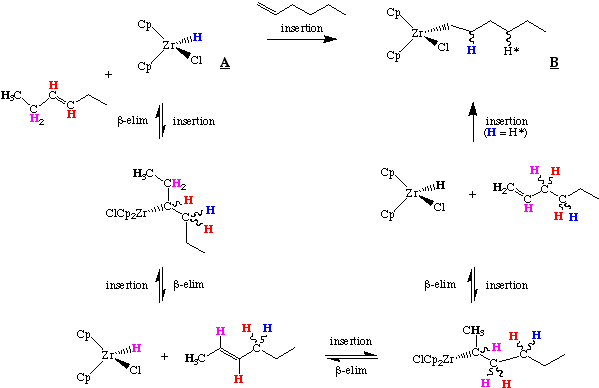
The Hydrozirconation reaction describes the reaction of an olefin (alkene) with Cp2ZrHCl, A, which is commonly referred to as Schwartz's reagent. In this reaction the insertion of either a terminal or internal olefin gives the same product, B. This isomerization occurs through a series of beta-hydride elimination and olefin insertion reactions as shown below.

While the scheme above suggests that the final location of the initial Zr hydride (blue) differs depending on whether we start with 1- or 3-hexene, students should convince themselves that this is not necessarily the case; i.e. the hydrogens can scramble.
These insertions and beta-hydride eliminations are quite fast and the olefin is rapidly isomerized to the terminal alkyl form, B. The Zr ends up at the least hindered accessible position in the alkyl chain. This is the thermodynamic product of the reaction and arises primarily from steric interaction with the Cp ring. In the example above, 1-hexene, cis-3-hexene and trans-3-hexene all give the same primary alkyl product. As the migration is driven by steric crowding of the Cp rings, the order of olefin reactivity is about what we would expect:
terminal > cis-internal > trans-internal >exocyclic > disubstituted > trisubstituted
As we also might expect, tetrasubstituted olefins or trisubstituted ones with bulky substituents do not react. The beauty of this reaction is that the resulting Zr-alkyl complex may be derivatized by a variety of reactions: protonation, bromination, insertion, etc., making it a versatile tool in organic synthesis.